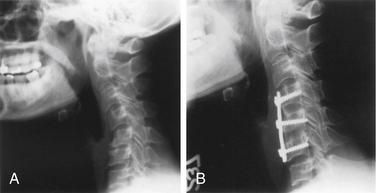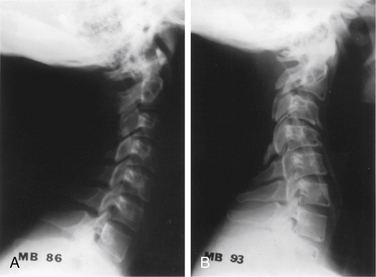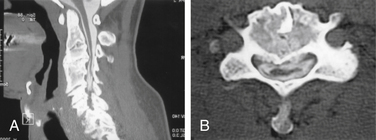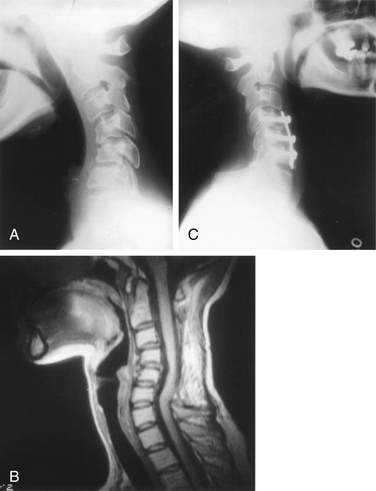Chapter 93 Subaxial Cervical Deformities
A deformity of the cervical spine may result from a variety of etiologies, including trauma, degenerative disease, congenital anomaly, infection, tumor, muscle denervation and neuromuscular disease,1 as well as iatrogenic causes such as surgery and irradiation. Cervical deformities may also occur in patients with systemic arthritides such as ankylosing spondylitis and rheumatoid arthritis.2 Likewise, patients with primary neurologic disorders such as athetoid cerebral palsy, spasmodic torticollis, and other movement disorders, as well as patients with neuromuscular disorders, are predisposed to develop cervical deformity due to degeneration. Patients with bone disorders such as osteogenesis imperfecta and spondyloepiphyseal dysplasia may also develop deformity involving the cervical region. Patients often present with complaints of neck pain, myelopathy, radiculopathy, or neck deformity with loss of mobility.
Subaxial cervical deformities most commonly occur in the sagittal plane, primarily as kyphosis, although hyperlordosis or a mixed swan-neck deformity can also be observed. Deformity in the coronal plane, manifesting as a scoliosis or angulation, is uncommon in the cervical region when compared with the thoracic and lumbar regions.3 Most cervical coronal deformities are the result of congenital vertebral anomalies.
Significance of Cervical Kyphosis
A considerable variation in the degree of cervical lordosis can be observed in the average patient population. Degenerative changes associated with aging typically produce a straightening of the spine, but the limits of normality are not established.4 After examining a group of asymptomatic patients, Gore et al. concluded that the normal cervical spine has a lordotic curve measuring approximately 15 to 20 degrees from C1 to T1.5 Generally, cervical kyphosis is defined as a ventral or kyphotic angulation of 5 degrees or more. The incidence of straightening or kyphosis increases with age for two reasons: (1) the cervical discs contribute to the normal lordotic curve, and (2) the loss of disc height and formation of osteophytes associated with degenerative changes produce a straightening of the spine. In some patients, increases in thoracic kyphosis associated with aging may produce a compensatory increase in cervical lordosis. Load transmission in the cervical spine is thought to be mostly in the posterior column; loss of sagittal alignment may occur if this axis is shifted ventrally.
After performing cadaver studies, Breig first called attention to the motion and degree of elongation of the spinal cord that occur during flexion and extension movements of the cervical spine.6 According to his measurements, there may be as much as a 45- to a 75-mm change in length of the spinal cord as a result of flexion and extension. Furthermore, there is relative motion of the cord in relation to the underlying vertebrae. Flexion movements produce tensile forces within the cord and elongation, whereas extension causes shortening or compression of the cord. Flexion also produces a decrease in the anteroposterior dimension of the spinal cord, but because of straightening of the dura and ligamenta flava, the available canal diameter is actually increased. Extension has the opposite effect. Changes in the normal configuration of the spinal canal caused by osteophyte formation, disc changes, or facet hypertrophy have the potential to compress or stretch the cord. Instability that results from ligamentous laxity, particularly when associated with a short, angular kyphotic segment, has an increased likelihood of inducing trauma to the spinal cord or adjacent nerve roots. The vascular supply could be decreased, leading to ischemia, which could in turn lead to neuronal loss and myelomalacia. Frequently, examination of the spinal cord in the axial projection demonstrates flattening that is most marked at the kyphotic segment. The potential for neurologic deficit arising from kyphosis without actual compression is small but certainly not nonexistent.
The degree to which these dynamic changes are clinically manifest is difficult to determine. Current imaging studies are performed with the patient recumbent and with the cervical spine in a neutral or slightly extended position, and the images produced are static. Although flexion-extension MRI has been advocated, especially to evaluate craniocervical junction instability, it has yet to receive widespread clinical use.
The significance of cervical kyphosis in the production of chronic muscle fatigue and dorsal neck pain is unclear. Although many patients demonstrate reversal of normal cervical lordosis on plain radiographs, a very small number actually have refractory neck pain as a result of the deformity per se. Nonetheless, an occasional patient appears to have pain on this basis and requires careful evaluation and consideration for deformity correction and fusion (Fig. 93-1).
Postlaminectomy Kyphosis
Kyphosis is a well-recognized complication of laminectomy of the cervical spine.7–15 The detachment of the dorsal paraspinous muscles, removal of the dorsal osseoligamentous complex, and occasional disruption of the facet complexes have all been recognized as potential causes of the development of a kyphotic deformity after laminectomy.16
The reported incidence of kyphosis after cervical laminectomy has been quite variable, although it is considerably more common in the pediatric group. The incidence of postlaminectomy kyphosis in series of pediatric patients ranges from 33% to 100%. Many of these patients, however, have other factors that predispose them to spinal deformity, such as bony tumors, neurofibromatosis, or irradiation. A recent series, which excluded these confounding factors, noted an incidence of kyphotic deformity of 53% in children.7 Although the data are mixed, it appears that a younger age and a greater number of segments treated with laminectomy are associated with higher rates of deformity. Injury or resection of the facet joints also increases the probability of kyphosis. Laminectomy of C1 has a relatively low tendency to result in spinal deformity. Although it has not been conclusively demonstrated that the performance of laminoplasty, as recommended by Raimondi et al.,17 reduces the likelihood of postlaminectomy kyphosis in children, many neurosurgeons who routinely perform cervical procedures on children perform laminoplasty, and some report evidence suggestive of benefit.18 Prophylactic fusion should also be considered for patients undergoing laminectomy who are at high risk for developing kyphosis.15 Dorsal fusions are much more effective at preventing kyphosis than at correcting it (Fig. 93-2).
The incidence of postlaminectomy kyphosis in adults is relatively uncommon in the absence of an additional predisposing factor such as facet joint damage, prior ligamentous instability, ventral column compromise, neurologic deficit, or irradiation.19,20 Adult cases are, nonetheless, seen in any busy practice specializing in spinal problems (Fig. 93-3). A recognition of the significance of this finding in terms of the probability of progression, the potential for symptoms, and the appropriate therapeutic options is essential for optimal management. Patients with the greatest risk of postlaminectomy kyphosis are those that have preoperative instability as well as those with straightening of the cervical spine. Additional risk factors include multilevel laminectomy, extensive facetectomy, and resection of the musculature at C2. Iizuka noted that removal of the semispinalis cervicis muscle attachment at C2 could lead to loss of alignment and kyphosis.21
Surgical Correction of Cervical Kyphosis
Preoperative Assessment
The preoperative evaluation of all such patients should include a careful neurologic assessment to look for subtle signs of myelopathy or radicular involvement. Plain cervical spine radiographs with flexion-extension views provide information about the deformity, including the levels involved, the severity, and whether it appears fixed or rigid. Neuroradiologic imaging with MRI or myelography and postmyelographic CT is important for evaluating spinal cord compression and the dimensions of the spinal canal. Assessment of the bony and ligamentous anatomy is also possible with these studies. Three-dimensional reconstructive CT has also been useful in assessing kyphosis, because bony detail, amount of deformity, and spinal canal encroachment can be visualized on one image (Fig. 93-4). The degree of spinal instability can also be assessed. Standing long-cassette films are helpful for evaluating overall sagittal spinal balance in patients with severe deformity. Concomitant thoracic kyphosis or fixed flexion contracture of the hip must be evaluated before consideration is given to “lordosing” a cervical kyphosis.
Surgical Techniques
Ventral Surgery
A ventral approach is preferred for cases in which there is insufficient anterior column height or insufficient ability to bear an axial load, such as with collapse of a ventral bone graft or compression fracture, with ventral pathology such as tumor or associated spondylotic bars producing myelopathy, or with a deformity that is rigid or incompletely reducible. Anterior surgery may also be indicated for focal areas of deformity. In addition, ventral surgery may be safer for the treatment of postlaminectomy kyphosis because surgery can be performed through an unoperated field (Fig. 93-5). The ventral approach has other advantages, including the ability to decompress the spinal cord ventrally and to use ventral interbody strut grafts that are loaded in compression, thereby enhancing fusion.22
Stay updated, free articles. Join our Telegram channel

Full access? Get Clinical Tree












